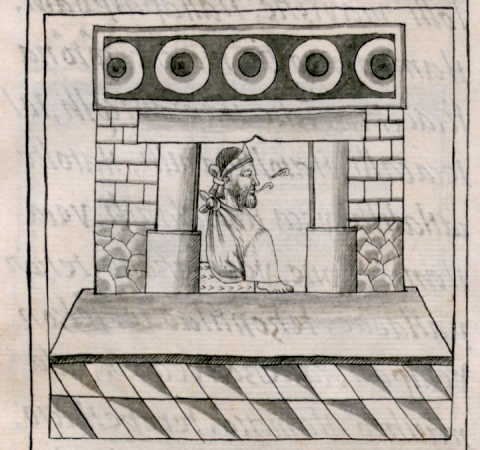tlatocacalli (FCbk11f241v)
This is either a compound glyph for a royal palace (tlatocacalli), or it can serve as an example of iconography. It appears on folio 241v in Book 11, “Earthly Things,” of the General History of the Things of New Spain, also known as the Florentine Codex. The glyph is outlined in black with some internal shading. It is facing towards the viewer (rather than in profile, as the norm in manuscripts such as the Codex Mendoza; see below). On the present example, there is a row of three full and two partial concentric circles just below the building’s flat roof. These circles are white within a black background. The inner circle is filled in with black with a sort of halo of gray surrounding them. Circles such as these are a common element on regal structures, suggesting power and prestige, and underlining the building’s status as something much more important than a simple calli (house). The lintel and sides of the doorway are shaded in gray, giving them a rounded (three-dimensional) look. The front wall of the structure is divided into two parts, the upper section below the range of circles displaying brick or stone-like rectangles, and the base made up of uncut stonework shaded in gray. A platform projects out from the front of the building adding some perspective. It rests on top of another wall made up of two horizontal rows of rhombus figures slanted to the left with dark gray shading running diagonally from the bottom right to upper left of each figure. All of these elements suggest a certain amount of Spanish influence. A bearded man facing right in profile is seated on a woven mat in the open doorway. He wears a peaked diadem on his head and has a cape elegantly knotted at his shoulder. Two speech scrolls issue from his mouth, a phonetic element for the Nahuatl verb “to speak” (tlatoa), which is an important element in the royal title tlatoani, ruler, “he who speaks.” The regal attire of this individual removes all doubt as to his status. Thus the compound glyph is really a sentence proclaiming “this is the house (or palace) of the ruler.”
Robert Haskett
This compound glyph appears near the end of Book 11 as an illustration for the alphabetic entry of tlatocacalli, the -ca- a connector joining the verbal preterite agentive
of the verb “to speak” to the noun for house (see the historical contextualizing image and gloss). Elsewhere, such structures are sometimes identified as tecpancalli, huei tecpancalli, and less commonly as tecpanchan. Arthur J.O. Anderson and Charles E. Dibble translated the opening part of Book 11’s Nahuatl text as, “It means the home of the ruler, or the government home, where the ruler is, where he lives, or where the rulers of the townsmen, the householders, assemble. It is a good place, a fine place, a palace; a place of honor, a place of dignity. There is honor, a state of honor.” [See Sahagún, Fray Bernardino, General History of the Things of New Spain: Book 11 – Earthly Things. Translated and edited by Charles E. Dibble and Arthur J. O. Anderson. Salt Lake City and Santa Fe: The University of Utah, The School of American Research and the Museum of New Mexico, 1963, 279.]
Robert Haskett
Tlatoca calli
Tlatocacalli
Robert Haskett
1577
Robert Haskett
palaces, houses, casas, palacios, rulers, reyes, líderes, tlahtoqueh, tlatoque, nombres de lugares

tlatoani, ruler ("one who speaks"), dignitary, judge, speaker, great lord, king, https://nahuatl.wired-humanities.org/content/tlatoani
tlatoa, to speak; to issue proclamations and commands (and, therefore, to govern), https://nahuatl.wired-humanities.org/content/tlatoa-0
cal(li), house, structure, building, https://nahuatl.wired-humanities.org/content/calli
el palacio real
Robert Haskett
Library of Congress, https://www.loc.gov/item/2021667856/.
The Library of Congress is unaware of any copyright or other restrictions in the World Digital Library Collection. Absent any such restrictions, these materials are free to use and reuse. Researchers are encouraged to review the source information attached to each item. If you do publish anything from this database, please cite the Visual Lexicon of Aztec Hieroglyphs.





